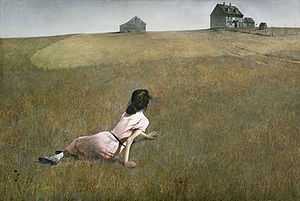Christina's World
 | |
| Artist | Andrew Wyeth |
|---|---|
| Year | 1948[1] |
| Type | Tempera on gessoed panel[1] |
| Dimensions | 81.9 cm × 121.3 cm (32 1⁄4 in × 47 3⁄4 in)[1] |
| Location | Museum of Modern Art, New York City |
Christina's World is a 1948 painting by American painter Andrew Wyeth, and one of the best-known American paintings of the middle 20th century. It depicts a woman lying on the ground in a treeless, mostly tawny field, looking up at a gray house on the horizon; a barn and various other small outbuildings are adjacent to the house.[1]
This tempera work, done in a realist style, is currently on display at the Museum of Modern Art in New York, as a part of its permanent collection.[1]
Background
The woman in the painting is Anna Christina Olson (3 May 1893 – 27 January 1968). She is known to have suffered from polio, a muscular deterioration that paralyzed her lower body. Although polio has been her standard diagnosis, more likely she was afflicted with Charcot-Marie-Tooth disease, a genetic disorder characterized by a progressive wasting away of the muscles, paralysis, and loss of sensation beginning in late childhood or early adulthood. Christina’s disorder had all of these features. (Polio produces a sudden, non-progressive paralysis unaccompanied by a loss of sensation.)[2] Wyeth was inspired to create the painting when he saw her crawling across a field while he was watching from a window in the house. Wyeth had a summer home in the area and was on friendly terms with Olson, using her and her younger brother as the subjects of paintings from 1940 to 1968.[3] Although Olson was the inspiration and subject of the painting, she was not the primary model — Wyeth's wife Betsy posed as the torso of the painting.[3] Olson was 55 at the time Wyeth created the work.[3]
The house depicted in the painting is known as the Olson House, and is located in Cushing, Maine. It is open to the public, operated by the Farnsworth Art Museum;[4] it is a National Historic Landmark, and has been restored to match its appearance in the painting. In the painting, Wyeth separated the house from its barn and changed the lay of the land.
Reception and history
Christina's World was first exhibited at the Macbeth Gallery in Manhattan in 1948.[5] Although it received little attention from critics at the time, the painting was quickly bought by Alfred Barr, the founding director of MoMA, for $1,800. Barr promoted the painting at MoMA and it gradually grew in popularity over the years. Today, it is considered an icon of American art and is rarely loaned out by the museum.[6]
Appearances in other media
In Arthur C. Clarke's novel 2001: A Space Odyssey, David Bowman notices Christina's World (along with Van Gogh's Langlois Bridge at Arles) when observing the living room of "an elegant, anonymous hotel suite" after travelling through the Stargate.
In Garth Ennis's graphic novel Preacher, the lead character's mother (also named Christina) connects with Christina's World on a personal level concerning her family history; the painting is shown a few times throughout the series.
In the fourth novel of Stephen King's series The Dark Tower, one of the gunslingers is reminded of this painting when one of his company finds a new wheelchair.
In Tideland (2005, dir. Terry Gilliam), the composition of several scenes with the character of Jeliza-Rose shows great formal similarity with the painting.[7]
In The Hypnotist (2012, dir. Lasse Hallström), during Simone's hypnosis sequence, we can see her on a hill with a house in the background, composition and light mimicking the painting.
The painting also appeared in several scenes of the movie Oblivion.
The painting also inspires a scene in Forrest Gump in which the character Jenny throws stones at her childhood home.
Within most live productions of Blue Man Group, the painting makes an appearance during the Group's "Twinkie Feast."
In the Netherlands, Dutch author Renate Dorrestein created an artistic world around the painting in her novella Want dit is mijn lichaam (For this is my body). In this short novel, the painting is called 'Maria's world' and is one in a series of several paintings made by painter Job Olson with his daughter Maria as a model. The characters are entirely fictitious but a note at the end of the story acknowledges 'Christina's world' as the main inspiration for this work. The novella was published in 1997 during the literary yearly festival 'Boekenweek', as a special gift for book buyers.
References
- ↑ 1.0 1.1 1.2 1.3 1.4 Christina's World in the MoMA Online Collection
- ↑ Philip A. Mackowiak
- ↑ 3.0 3.1 3.2 Corliss, Richard (1986-08-18). "Andrew Wyeth's Stunning Secret". Time. Retrieved 2008-01-19.
- ↑ "The Olson House". Farnsworth Museum.
- ↑ Kimmelman, Michael (January 16, 2009). "Andrew Wyeth, Painter, Dies at 91". The New York Times. Retrieved May 5, 2012.
- ↑ Esaak, Shelley. "Christina's World by Andrew Wyeth". About.com. Retrieved 5 May 2012.
- ↑ http://www.brnrd.net/blog/archive/2007/04/01/tideland
External links
- Christina's World -- an art song by Richard Rosing.
- Talk given by Richard Turnbull of the Museum of Modern Art on two paintings: Pavel Tchelitchew's Hide-and-Seek to Andrew Wyeth's Christina's World. (Scroll down to "MoMA Multimedia".)